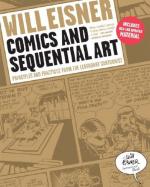
|
| Name: _________________________ | Period: ___________________ |
This test consists of 5 multiple choice questions, 5 short answer questions, and 10 short essay questions.
Multiple Choice Questions
1. Why must the sequential artist and the reader share any experience?
(a) So the artist can get paid.
(b) So communication can occur.
(c) So the panels are read correctly.
(d) So the reader understands the entirety of the piece.
2. What can be used when facial expressions are critical?
(a) Close-ups.
(b) Panoramic views.
(c) Heavy lines.
(d) Narrow channels.
3. From which point of view must the creator render the elements?
(a) Reader/viewer's.
(b) The panel's.
(c) Character's.
(d) Creator's.
4. What must be broken down into segments when using a full-page frame?
(a) Plot and action.
(b) Meter and rhythm.
(c) Scenes and pages.
(d) Words.
5. What is one of the two examples of time measurement Eisner mentions?
(a) Minutes.
(b) Radiation.
(c) Morse code.
(d) Radiowaves.
Short Answer Questions
1. In which 18th century tool do inscriptions reappear?
2. Why is time harder to measure in comics?
3. What can the frame's shape or absence convey?
4. What does lettering often serves as an extension of?
5. The earliest use of balloons was in what culture?
Short Essay Questions
1. Where does the emotion or "intuitiveness" of a panel come from?
2. What can the artist be tempted to compromise for the sake of attracting buyers?
3. What is the function of balloons?
4. Briefly give a synopsis of Chapter 3.
5. Why is the repetitiveness of comics compared to a language forming its own grammar?
6. How do people normally measure distance?
7. How does Eisner analyze a long Spirit story, "Foul Play," to show how time is realized through the sequence of events?
8. When inscriptions reappeared in the 18th-century, what did artists use to arrange their thoughts and actions for the audience?
9. Why do images without words require extra sophistication in the reader/viewer?
10. What does communicating ideas involve?
|
This section contains 738 words (approx. 3 pages at 300 words per page) |

|




